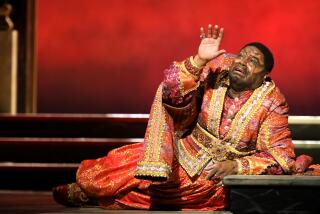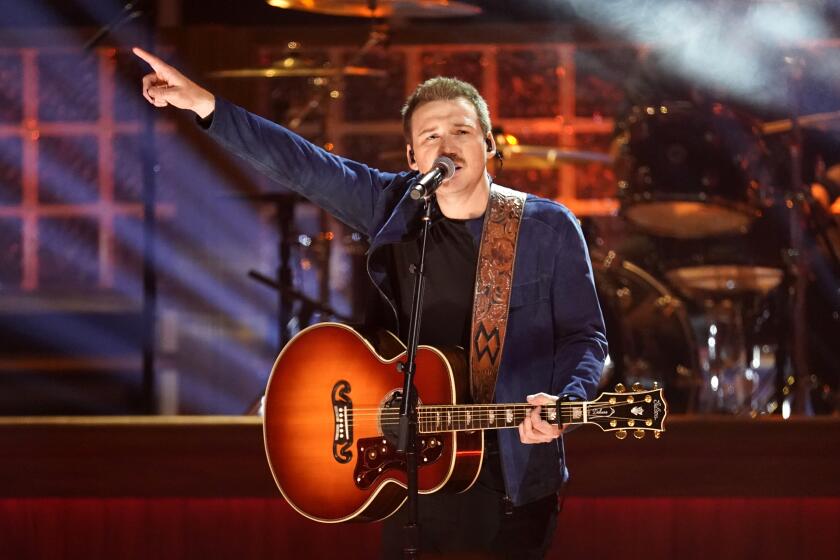Review: A protean John Zorn musical marathon at LACMA and UCLA
John Zorn is a defiant, protean musician, inescapable on the American scene everywhere it would seem except Los Angeles. But after a 25-year absence, he was back this weekend to proteate.
Is that a verb? Maybe not yet. But Zorn made it one with a marathon on Saturday. It began at 10 a.m. at the Los Angeles County Museum of Art with a Syrian oud player performing music updating a traditional Jewish melodic style in front of a 9th-century BC Assyrian relief of an eagle-headed goddess. The Zorn day ended past midnight at UCLA with the composer wailing, like a certain phantom, on the Royce Hall organ. Zorn may become a verb as well.
Zorn’s defiance is attitudinal, in that he is a proudly anti-establishment bad boy of American music. His defiance is also categorical. He experiments with so many stylistic and genre barriers — classical, rock, jazz, traditional Japanese music, nontraditional Japanese music, radical klezmer, Italian film music and on and on — that he is in a class of his own.
As for protean, there are those many musical worlds he inhabits as composer, saxophonist and keyboard player. He is prolific. “You just turn on the tap,” he has said, “and it flows out.” Anti-establishment he may be, yet there is an extensive Zorn avant-garde brand that includes a record label (Tzadik), a couple of clubs in New York and a goodly number of bands of various musical types he has formed over the years.
And then, there are his pronouncements. He doesn’t like to play by the rules, but he does like to make them. No photographs at his concerts. (The Times obeyed; his fans snapped away.) He bans live recordings (except when he doesn’t). He refuses to have anything to do with the press, and he would forbid reviews if he could get away with it. He insists that music is to be shared in the moment and not beyond.
An unusual collaboration between the Center for the Art of Performance at UCLA and LACMA, the day started with Zorn presenting a piece or two in each of 10 museum galleries over five hours. With the exception of an unfettered improvisation between Zorn on sax and Dave Lombardo on drums in front of Jackson Pollock’s “Black and White Number 20” and electronic music wafting spookily around the ancient Egyptian art, the pieces represented Zorn’s more formal ensemble scores.
These and particularly Zorn’s string quartet music capture the fullest and most remarkable aspect of his protean nature. The style can change every few seconds. The transitions are often jarring. But Zorn’s vision is huge. The effect is like a map of the world coming to life; you not only see each region’s terrain but also experience its people and culture.
The powerhouse JACK Quartet played “The Alchemist,” a string quartet inspired by the occult writings of Aleister Crowley, in front of Rembrandt’s “The Raising of Lazarus.” Zorn — who like a new-music warrior wore military fatigues and a black T-shirt with a skull on it — warned the audience against coughing. A spell was created.
Bits that sounded like late Beethoven and bits that sounded like John Coltrane and bits that sound like a whole lot of others things became charged in this intimate space. The concerts were open to all who happened to be at the museum. People sat on the floor close to players and pictures. JACK played with a sense of overwhelming supremacy. I’m not so sure about the dead being raised, but Rembrandt’s dark canvas did seem to pulsate.
For the electronic score, I found myself eye to eye with a mummy mask of a woman with big quizzical eyes, small, tight lips and pug nose. She looked like an ancient version of a Keane; this time, Zorn’s associating old music and new may have gone too far. In the Pacific Gallery, percussionists William Winant and Nava Dunkelman called forth other odd spirits on big bass drums. That was illuminating.
At Royce in the evening, Zorn presented a three-hour triple hitter with two rock bands and a jazz trio. With “Psychomagia,” the four-member Abraxas turned folk-like tunes into quick trips to shrieking electric guitar ecstasy.
Secret Chiefs 3 then took up the second book of Zorn’s “Masada,” and again, Jewish-inspired tunes got jacked up in volume. There was more nuance here, in that the band included a violinist (Eyvind Kang), but there was also more convention in Secret Chiefs 3, especially its reliance on an over-punctuated backbeat.
With Bladerunner — featuring Zorn on sax, Lombardo and bassist Bill Laswell — there was dazzlingly feverish noise, disarming lyricism and stimulating sonic massages aimed at each listener’s solar plexus.
Zorn’s midnight organ ride wasn’t as inspired, but it was wild. He took off with the chiming of bells in the background and the rumbling of the organ’s lowest notes imitating the sounds of a Harley-Davidson starting up. He then began pulling stops with the indelicate gusto of a noisy motorcycle racing up Pacific Coast Highway.
I have never heard an unamplified organ make such a racket or sound so unhinged. The most protean of all acoustic instruments met its brazen match.
More to Read
The biggest entertainment stories
Get our big stories about Hollywood, film, television, music, arts, culture and more right in your inbox as soon as they publish.
You may occasionally receive promotional content from the Los Angeles Times.







